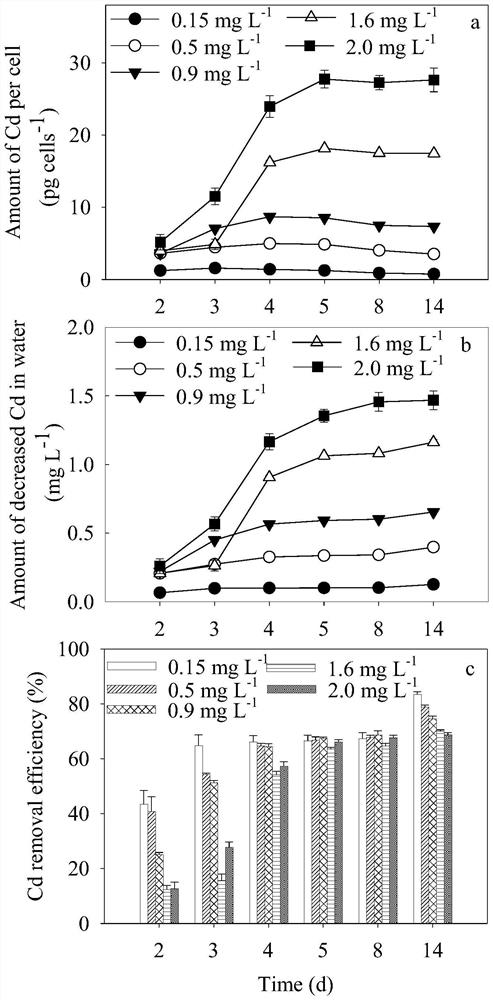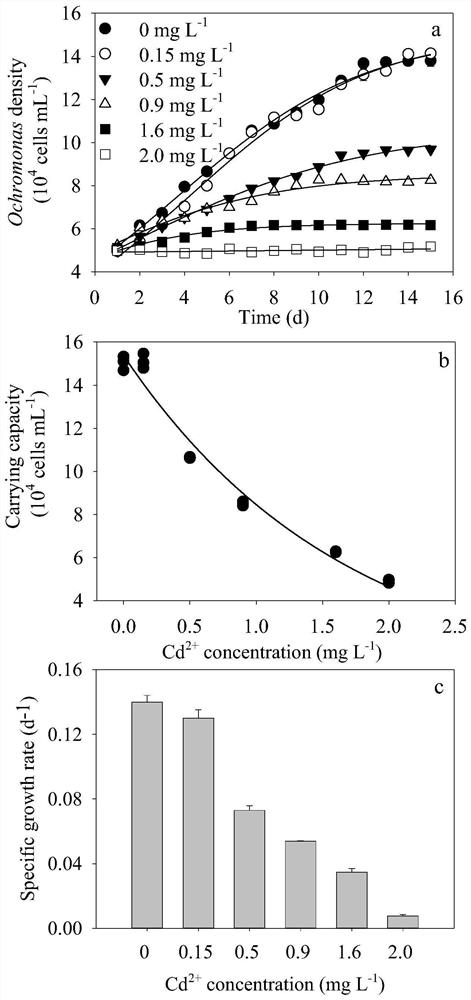Biological treatment method for removing dissolved cadmium in water body
A biological treatment and dissolved state technology, applied in the direction of biological water/sewage treatment, water/sludge/sewage treatment, water pollutants, etc., can solve problems such as high requirements and high growth dependence on photosynthesis
- Summary
- Abstract
- Description
- Claims
- Application Information
AI Technical Summary
Problems solved by technology
Method used
Image
Examples
Embodiment 1
[0036] Experiments were carried out in 250 mL Erlenmeyer flasks containing 150 mL of sterile BG-11 medium. Prepare CdCl before experiment 2 Mother liquor (Cd mass concentration is 200mg L -1 ), by adjusting the volume of the mother liquor added to the Erlenmeyer flask to obtain 0, 0.15mg L -1 , 0.5mg L -1 , 0.9 mg L -1 , 1.6mg L -1 and 2.0mg L -1 Dissolved cadmium medium, followed by 5×10 4 cells mL -1 The initial density of brown flagellates was added to the Erlenmeyer flask, and three replicates were set up for each treatment. The experiment lasted 15 days, and the culture conditions were as above. The population growth of brown flagellates and the removal of dissolved cadmium in water during the observation period.
[0037]The results showed that with the increase of the initial cadmium concentration, the ability of brown flagellates to remove cadmium from water was enhanced ( figure 1 a), after 5 days, the removal amount of cadmium per unit cell brown flagellate ...
Embodiment 2
[0040] In order to meet the cadmium removal requirements of water bodies with different inorganic nutrient contents, in Example 2, the nutrient parameters affecting the ability of photoautotrophic brown flagellates to remove cadmium were studied. Before the experiment, brown flagellates were starved for 3 days in BG-11 medium without nitrogen and phosphorus, and then inoculated with different nitrogen (0.2 mg L -1 , 2mg L -1 and 8mg L -1 ) and phosphorus concentration (0.02mg L -1 , 0.4mg L -1 , 1mg L -1 , 2mg L -1 and 4mg L -1 ) medium for 2 weeks, different nitrogen and phosphorus concentrations were achieved by adjusting the contents of sodium nitrate and potassium dihydrogen phosphate added to the BG-11 medium. Set the initial concentration of cadmium in the water to 0.9mg L -1 , the initial cell density of brown flagellates was 5 × 10 4 mg L -1 , culture conditions as above. Observe the removal of dissolved cadmium in water by brown flagellates under different n...
Embodiment 3
[0043] This example verifies the ability of mixed trophic brown flagellates to remove cadmium. Brown flagellates containing 100mg L before the experiment -1 The glucose medium was acclimatized and cultured for two weeks, and the remaining glucose concentration in the medium was measured every day and added to 100mg L -1 . After the domestication culture is over, take brown flagellates in the logarithmic growth phase and carry out the verification experiment. The experiment is carried out in an Erlenmeyer flask containing 150mL of medium. Refer to Example 1 to set 0mg L in the culture system. -1 , 0.2mg L -1 , 0.6mg L -1 , 1.0mgL -1 , 1.9 mg L -1 and 2.4mg L -1 The concentration of cadmium in the water body, then 5×10 4 cells mL -1 The initial density of brown flagellates was inoculated, and the glucose concentration in the culture system was detected every 12 hours during the experiment and added to 100mg L -1 level, and other culture conditions as above. Observe the...
PUM
 Login to View More
Login to View More Abstract
Description
Claims
Application Information
 Login to View More
Login to View More - R&D
- Intellectual Property
- Life Sciences
- Materials
- Tech Scout
- Unparalleled Data Quality
- Higher Quality Content
- 60% Fewer Hallucinations
Browse by: Latest US Patents, China's latest patents, Technical Efficacy Thesaurus, Application Domain, Technology Topic, Popular Technical Reports.
© 2025 PatSnap. All rights reserved.Legal|Privacy policy|Modern Slavery Act Transparency Statement|Sitemap|About US| Contact US: help@patsnap.com



